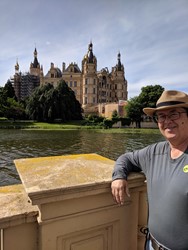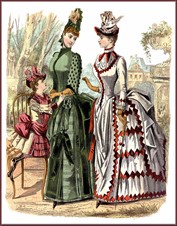Archive for the ‘Germany’ Category
Mining the Past
 No one can beat the Palatines to America organization for educating genealogists on the ins and outs of German research. I have learned so much at their twice-yearly seminars in Denver over the past twenty years. Now another great opportunity to learn from them is coming up next week.
No one can beat the Palatines to America organization for educating genealogists on the ins and outs of German research. I have learned so much at their twice-yearly seminars in Denver over the past twenty years. Now another great opportunity to learn from them is coming up next week.
The Colorado chapter of the Palatines will host a 3-day national conference in Denver on June 16-18. I am looking forward to all they have to offer at this conference:
- First up on Thursday will be a bus tour of local German heritage sites. This includes a stop for lunch at a German restaurant.
- On Friday, Daniel Jones, the German and Swiss research specialist at the Family History Library in Salt Lake, will speak on four topics. These will cover beginning Swiss research, tools for reading German documents, German military records, and a case study.
- Dr. Wolfgang Grams of Oldenburg, Germany will lecture on Saturday about German migration and German resources to be found in repositories and online.
- In between events, translation and research consultations will be available.
- Scheduled social times will be a Thursday evening no-host get acquainted event, and a Friday night cocktail hour and banquet.
We have never before attended a Palatines national convention. This one in our own back yard will give us the chance for an enjoyable long weekend coupled with the chance to add to our genealogical know-how.
A bonus will be meeting German researchers from other parts of the country. My husband/tech advisor and I took over as newsletter editors for the Colorado Chapter of Palatines earlier this year. We are already on the hunt for news and articles to print in this twice-yearly publication. Getting networked into the national organization will help us with this. Attending the national conference will be a great way to begin.
The theme for this year’s national conference is Mining the Past. I am hoping to find some nuggets of inspiration for our German research during the inviting conference ahead.
23andMe Sheds Light on a Family Mystery
 My quest to identify my German great-great grandmother never ends. If I am not actively working on the project, it still simmers in the back of my mind.
My quest to identify my German great-great grandmother never ends. If I am not actively working on the project, it still simmers in the back of my mind.
We inherited such brief information about this woman. My great-aunt (the German woman’s granddaughter) told me in the 1980’s that her grandmother’s name was Katherine Stillenbaugh. She came to America when she was eight years old, and she died at Indianapolis shortly after giving birth in 1865 to her only child, my great-grandmother.
My great-uncle, the informant on his mother’s death certificate in 1961, gave the name of his grandmother as Katherine Stanabaugh.
Both these records date from a century after my second great-grandmother lived. People who never knew her, people with little formal education, created these records.
What is the truth? Who was she? More importantly, who were her people?
Through years of work with the U.S. census and Indiana records, I made a little progress. I learned that there are few, if any, Stillenbaugh or Stanabaugh families in Germany or the US. The one or two I found have no connection to Indiana or a Civil War era woman named Katherine.
I learned that Germans usually spell the female name with a “C” instead of a “K”, as in Catherine, Catharine, or Catherina.
I learned that when you cannot find information about early American women, the standard advice is to follow the men in their lives because the men created more records. My second great-grandfather’s name was Thomas Sherman, a blacksmith from Kentucky.
Sometime during the early 1860’s, he and other siblings resettled in Indiana, south of Indianapolis. When I looked at the names of their neighbors, a found a large German clan named Stilgenbauer, a name some of them Anglicized to Stillabower. The name struck me as so similar to the names I had been researching.
I hypothesized that my Katherine belongs to this German family. Various branches of this group had daughters named Catherine. Is one of them mine?
None appeared to fit the bill exactly. Some seem too old, others too young. Some of the right age were born in America, not Germany. I could find no record of any of them marrying someone named Sherman. It seemed I would never find an answer.
Then DNA testing came along. My father and I submitted our samples, and I began combing the databases looking for matches to Stilgenbauer/Stillabower descendants. Several months ago, I found one, and his family was from Indiana. He works as a genealogy librarian, but he could not identify my Katherine.
This week I uncovered another match to an Indiana Stillabower. With two DNA matches who match each other and us, I am feeling pretty confident that I have found my kin.
Indiana county histories tell me that all the Stilgenbauer/Stillabower descendants claim a common ancestor, Georg Valentin Stilgenbauer (1773-1845) from Bavaria. He must be my ancestor, too.
But where do I fit in? Georg had three sons who settled in Indiana. Jacob (1796-1865), Adam (1801-1863), and Johan Michael (1804-1881) all settled in Brown County.
Jacob’s son, Johan Nicholas (1823-1905), spelled his name as Stillabower. He eventually moved on to the northern edge of Bartholomew County. My great-grandmother was born in April, 1865 just a few miles north of there in Edinburg, Johnson County. Was she Nicholas’ granddaughter? Nicholas did have a daughter named Catherine who was 18 years old in 1865.
But this Catherine did not die in 1865. Instead, she married a man named Long that same year and lived to have a family with him.
So the story still does not match up, but I am getting closer. It may take better scientific skills than I possess to interpret the DNA results that continue to come in. Nevertheless, I hope to resolve this puzzle someday. My great-grandmother’s maternal grandfather was likely one of the Stilgenbauer brothers who settled in Brown County, Indiana.
The Trip—Part 4
Our recent Baltic cruise ended with two stops in one of my favorite countries, Germany. Both locations had genealogical significance for my husband/tech advisor. He was eager to see the ports of Rostock and Kiel and the surrounding countryside.
His mother’s German family originated in various areas of Germany including the coastal states of Mecklenburg and Schleswig-Holstein. He continues to work to locate precise information about his ancestors who probably lived there several hundred years ago.
In Mecklenburg, we docked in the old Hanseatic port city of Rostock. There we toured Schwerin Castle. It sits alongside a beautiful lake, and we had the opportunity to view the building from the water. Inside, we saw only part of the interior because the remainder had suffered water damage from rain the day before. Not only does this building serve as a museum for historic Mecklenburg, but it also houses the local parliament. We found it to be a busy place.

After our tour, we took an open-air tram to a restaurant. Later, we enjoyed some free time for shopping and ice cream. As we walked around the old city center, we wondered whether any ancestors had ever visited Rostock.
Our ship docked the next day in Kiel, the capital of Schleswig-Holstein. The city had close ties with the Vikings and the Kingdom of Denmark from the Middle Ages until the nineteenth century. Although it was heavily bombed in World War II, it has now been completely rebuilt.
We visited the Kiel area on a sunny Sunday, traveling by bus and by ferry. This gave my husband/tech advisor a great opportunity to view the lands of his ancestors. Most places in Germany close on Sundays, and we found that the Kiel area follows this practice. We were glad we had done our German souvenir shopping the previous day.
This region provided us with some of the great German food that we love. We stopped for lunch at a modern-looking, family-owned place where we had beer, wine, and schnitzel. No one will forget this meal after a young waitress spilled an entire tray of beers on one unfortunate woman’s head. The good-natured victim was very gracious, saying that she had always wanted to try a beer shampoo. After we got her cleaned up and had eaten our meal, we all enjoyed some schnapps. To our delight, the proprietors gave us additional bottles of schnapps to take home.
Later in the afternoon, after our ferry ride, we had the opportunity to stop for coffee and German pastry in a small shop. Boarding the bus again, I began to eye the clock. Our all-aboard time for the ship was 3:30. To my relief, the bus rolled up to the terminal at 3:26.
I needn’t have worried. Eco-terrorists had our ship hemmed into the harbor. It took the German police 6 hours to clear them out. Our waiter at dinner said this had never happened before, but I wonder whether it will become a regular occurrence at the German ports. It would be a shame if the ships had to stop visiting there.
Stops in Mecklenburg and Schleswig-Holstein provided us with the opportunity to see the lovely, lake-filled area of northern Germany. We wondered, as we always do, how our ancestors could bear to leave such a place. We know that economics or war always gave people the reason to leave, but still it must have been a hard thing for them to do.
Thanks to the Palatines To America
 Last weekend the Colorado chapter of Palatines to America, a national group that researches German-speaking ancestors, hosted a half-day session at the Denver Public Library. The speaker was Katherine Schober, a German-English genealogy translator.
Last weekend the Colorado chapter of Palatines to America, a national group that researches German-speaking ancestors, hosted a half-day session at the Denver Public Library. The speaker was Katherine Schober, a German-English genealogy translator.
My husband/tech advisor (who is half German) and I decided to go. We were glad we did.
Katherine addressed a couple of topics including an introduction to German genealogical research and some tips and tricks for deciphering German handwriting. She introduced us to helpful websites.
Katherine was a good, entertaining speaker. She also took time during a break to look at a puzzling, centuries-old German document related to my husband’s family. She identified it as a journeyman’s record. This is an exciting find for us.
From her presentation, we picked up several good strategies to use as we pursue our own research. I also picked up an application to join the Palatines organization.
Over the years, I have attended many of their events. My motive was to become more knowledgeable and help my husband with his research. Now, with a recent DNA match to a German family in my dad’s line (Stillabower), I feel like I can join this German group on my own behalf.
Katherine, Still MIA
 Despite several hours’ work, I have made no real progress in my search for my elusive German ancestor, Katherine Stillenbaugh/Staninbaugh. I have been unable to find any evidence supporting the hypothesis that she belonged to the Stilgenbauer/Stillabower clan that lived south of Indianapolis, IN in the 1860’s:
Despite several hours’ work, I have made no real progress in my search for my elusive German ancestor, Katherine Stillenbaugh/Staninbaugh. I have been unable to find any evidence supporting the hypothesis that she belonged to the Stilgenbauer/Stillabower clan that lived south of Indianapolis, IN in the 1860’s:
- Using census records and county histories, I constructed family trees for the three immigrant patriarchs who lived in that area: Jacob (1796-1865), Adam (1801-1863), and Johan Michael (1804-1881). Although I found several daughters and granddaughters, some named Catherine, none of these girls seem to fit the profile of my ancestor. Either they were born in the U.S. instead of Germany, died in childhood, or married someone other than my Thomas Sherman.
- I combed through the online databases for the Allen County Public Library, the Indiana Historical Society, the Indiana State Archives, and the Indiana State Library. I found almost no mention of either the Sherman family or the Stilgenbauer/Stillabower family.
- I reviewed the Family Search catalog for Johnson County, Indiana (where the Shermans lived and Katherine’s daughter was born in 1865) to determine whether they hold any records I might find helpful. The Johnson County courthouse burned in 1874, so many records were lost. They do not have much that I have not already analyzed.
Where do I go from here? I have a few steps in mind:
- Family Search does have a microfiche copy of an 1866 land ownership map for Johnson County. I could order that to help re-create the Sherman’s neighborhood at that time. People came and went between census years, and the map might hold additional names to search.
- One of Thomas Sherman’s sisters married Stephen Dyke, and this family remained in Johnson County after most of the other Shermans had moved on to Illinois and Missouri. I have done little research on the Dykes. Perhaps the records of these relatives hold a clue to my Thomas and his first wife.
- The Stilgenbauer/Stillabower families lived primarily in Brown and Bartholomew Counties, both adjacent to Johnson County. I can do more research in the records of those counties.
- I have not yet looked at land and probate records. I have not found an online source, and perhaps these records were destroyed in courthouse fires. I need to investigate this research avenue.
- DNA testing could provide a connection to the Stilgebauer/Stillabower line. I need to review our matches for this possibility.
In the meantime, Katherine remains a brick wall ancestor.
An Expanded Search
 Despite some diligent research, my attempt to identify my German 2nd great-grandmother, Katherine Stillenbaugh, has gone nowhere this week. I need to broaden the search.
Despite some diligent research, my attempt to identify my German 2nd great-grandmother, Katherine Stillenbaugh, has gone nowhere this week. I need to broaden the search.
Family lore tells me that this woman immigrated at the age of 8, gave birth to my great-grandmother, Anna Petronellia Sherman, at Indianapolis in 1865, and died shortly thereafter. I have not found a marriage record for her. With no birth and death records kept that early in Indiana, I must use other means to pinpoint this little family of Thomas, Katherine, and Anna P. Sherman. An Indiana census record would have been nice.
As far as I know, Indiana did not conduct a census in 1865 so I am out of luck for that year. Because Katherine had died by the time of the 1870 U. S. census, her name would not appear there. Indeed, by 1870 little Anna Petronellia lived with her paternal grandmother, Rebecca Sherman, in Illinois.
That leaves me looking back before the Civil War to the 1860 U. S. census. Did Katherine live in Indiana in 1860? No family named Stillenbaugh lived there, or anywhere else, for that matter. Stillenbaugh must be a corruption of her family’s true German name.
I discovered a clue to what it might have been by following the movements of the husband, Thomas Sherman. In 1860, he was a single man living in his parents’ household in Kentucky, not Indiana. However, his older brother Anderson did live in Indiana by then, in Hamblen Township, Brown County, just south of Indianapolis. And Anderson was surrounded by German neighbors named Stillabower.
Were these my Katherine’s people? None of the six families had a daughter Katherine/Catharine in 1860 although Michael P. had an 8-year-old Mary C. Family information found on FindAGrave.com tells me that these families, all related, included three immigrant brothers, Jacob, Adam, and Michael, and three of their sons, Michael C., Michael P., and John. The FindAGrave site also tells me that the Stillabower family had many more members than just these. In fact, the original German name was Stilgenbauer, and they were Lutherans from Bavaria. Some settled first in Ohio and later moved on to Indiana.
Looking beyond the 1860 census, I know that by 1863, Anderson Sherman had moved out of Brown County and into neighboring Johnson County, also just south of Indianapolis. Thomas lived there, too. Another younger Jacob Stillgenbauer lived nearby. Unfortunately, in 1860 he did not have a daughter named Katherine/Catherine either, but he did have a 10-year-old girl named Caroline. Caroline? Catharine? It is a possibility, but she would have been just 15 in 1865. I cannot presume that she was my girl. Still, her later whereabouts are worth a look.
And that is where my search ended this week.
Armed with the information uncovered so far, I plan to do some more investigation of this German Stilgenbauer family, both elsewhere in Indiana and in other states where family members may have resided before landing in Indiana. The Civil War disrupted people’s lives, and folks moved around during those years. My Katherine could have lived anywhere in 1860.
I also hope to learn whether any Lutheran church records for the 1860’s Indianapolis area survive. I have found no county marriage record for Thomas and Katherine in Indiana. If the Stilgenbauers were Lutheran, perhaps this couple married in the Lutheran church even though Thomas probably was not Lutheran himself. He did not seem averse to a church wedding because a Methodist minister officiated at his second marriage to Mary Scott in 1872.
My other research possibility is to look for Stilgenbauers on the 1850 U.S. census. The difficulty with this is that I do not know what year Katherine was born or what year she immigrated. A young woman married to a 23-year-old man (Thomas) by 1865 was likely born in the 1840’s. My family says Katherine left Germany at the age of eight, so perhaps she was in America by 1850. From the FindAGrave information I cannot tell with any precision when the Brown County Stillabowers immigrated. The older Adam was said to have come over in 1836, while Jacob’s son Adam was born in Germany in 1838. If this was my family, other relatives, including mine, may have followed in the 1840’s and 1850’s.
This leaves me with so many people to sort through. The time-consuming search for my Katherine continues. Stay tuned.
A Step-By-Step Plan for Finding Katherine
 I am on the hunt for any information available on my 2nd great-grandmother. So far I have turned up almost nothing, but I am not discouraged yet. I am pursuing a research plan, step-by-step.
I am on the hunt for any information available on my 2nd great-grandmother. So far I have turned up almost nothing, but I am not discouraged yet. I am pursuing a research plan, step-by-step.
The search began at home with tales of family lore. My dad’s cousins and aunts told me that the elusive woman’s name was Katherine Stillenbaugh/Stanabaugh, and she immigrated from Germany when she was eight years old. She died at Indianapolis shortly after giving birth to my great-grandmother, Anna Petronellia Sherman, in 1865.
I have done an exhaustive search on Katherine’s reported husband, my second great-grandfather Thomas Sherman. I have had no luck connecting him to this alleged first wife or her family. He did live south of Indianapolis during the Civil War, so at least that much of the story matches.
Armed with these bits of information, I began my search for Katherine in earnest earlier this month. My steps:
- Thomas Sherman and his brother actually resided in Johnson County, Indiana, not Indianapolis, so I looked at the county histories for that location. I found no mention of the Sherman family or any German family with a name similar to the one I seek. I did not find an Indiana marriage record for my Thomas Sherman in the 1860’s.
- A search of the 1860 U.S. census for Johnson and surrounding counties turned up an extended German family named Stilgenbauer or Stillabower. This family name sounds promising, and I decided to do some research on them to find out whether anyone had a likely daughter named Katherine.
- On FindAGrave.com, I found memorials for many members of this Stilgenbauer family. Each contained links to the others. This family descends from three brothers (Jacob, Adam, and Johan Michael) who immigrated from Bavaria—a German state. Interestingly, these southern Germans seemed to be Lutheran, not Catholic. This information fits, too, because Thomas Sherman was Protestant, not Catholic, and it is unlikely he would have married into a Catholic family. Thank you to Mike E. Wirey who created all these memorials in 2007.
- I spent a considerable amount of time this week reviewing Wirey’s information and reconstructing the Stilgenbauer family relationships on a white board. Catherine seems to be a common name with them, but I did not spot a girl who fit the profile of my Katherine. They all either died quite young or had married names other than Sherman.
Still more digging remains to be done. The FindAGrave information is not a complete family tree. What will I do next?
- I can try to contact Mike E. Wirey to find out if he has any additional Stilgenbauer information, particularly on girls named Katherine.
- I can look at the 1860 U.S. census for Johnson and all the surrounding counties for more members of the Stilgenbauer family to see if I can find another Catherine who seems a better match for my ancestor.
- I can take a DNA test to find out if I am match for any Stilgenbauers or their descendants who might have taken a test.
- I know where Thomas Sherman lived in 1863, and I can reconstruct his neighborhood, looking for clues.
- I can work to identify pertinent records at the Johnson County Museum, the Johnson County Historical Society, and other repositories. Did Thomas Sherman associate with the Stilgenbauers, or did the families have associates in common? Thomas had a German sister-in-law named Mishler, so I know his family associated to some extent with their German neighbors.
This search promises to take a long time. I probably will never find a single piece of paper proving the identity of my ancestor. But I can pursue my research plan in the hopes of identifying a likely candidate and then building enough circumstantial evidence to prove a case.
Genealogy Goals for 2017
Happy New Year to everyone! Are we all ready to begin another exciting chapter of Reed/Bentsen family research? I know I am. I hope to accomplish a number of things in 2017:
- My German third great-grandmother, Katherine Stillenbaugh/Stanabaugh (d. abt. 1865), remains a mystery to me, and I would love to break through this brick wall. I have developed a research plan to see if I can find any clues about her. This week I began by reading through the published histories of Johnson County, Indiana where I suspect she lived. Unfortunately, I found nothing that shed any light on her. My next step will be to identify families in Johnson and surrounding counties with surnames similar to hers and reconstruct those family groups to see if I can identify a possible candidate for her family. Anyone missing a daughter Katherine/Catherine/Catharina who might belong to me?!
- Technically, I finished up my series 52 Ancestors in 52 Weeks in 2016. One year did not allow me enough weeks to complete the stories of all my third great-grandparents. Notably, I did not get to my Finnish line (ha, ha). I intend to do a few more posts on this topic so that I have something written about that entire generation.
- I plan to take up the challenge presented by Family Search and do a series on 52 Stories. The project involves writing a post every week about my own life. Family Search provides a year’s worth of prompts to inspire good material for this. First up, Goals & Achievements. When I am finished, I will have a nice memoir that I can pass along to my descendants.
- Later this year I will take a fabulous trip to Germany and the Czech Republic. My Lutheran church choir will go on tour to celebrate the 500th anniversary of the Reformation, and we will visit all the historic Luther sites. My maternal family has been Lutheran since the Reformation, so it means a lot to me to have the opportunity to explore my spiritual roots. My husband/tech advisor and I will tack a few days on to the trip to visit his ancestral villages in Germany and the Netherlands. If I could find out where my mystery ancestor originated in the German lands, perhaps I could visit her villages, too.
- I still have an unviewed box of material and several notebooks inherited from my Dad’s cousin awaiting curating. I would like to complete this project this year. Many of her materials concern her maternal line, which is not related to me. I would like to identify and donate these items to the Denver Public Library for the benefit of other genealogists.
These goals should keep me busy through the year. Wish me luck!

52 Ancestors in 52 Weeks nos. 37 & 38, The Stanabaughs
 I know nothing about my ancestors, Mr. and Mrs. Stanabaugh. I do not even know whether this is their real name. In fact, it probably isn’t. Why not, and where did we find it?
I know nothing about my ancestors, Mr. and Mrs. Stanabaugh. I do not even know whether this is their real name. In fact, it probably isn’t. Why not, and where did we find it?
- The name comes from that provided on my great-grandmother’s death certificate in 1961. It lists the decedent’s mother’s name as Katherine Stanabaugh. This information was provided by my great-grandmother’s second-to-youngest child, almost a hundred years after the said Katherine Stanabaugh had passed away. Talk about second-hand information!
- I have a letter from my great-grandmother’s oldest child saying that the mother’s name was Katherine Stillenbaugh. This letter was written even later, in the 1980’s, when the writer was nearly 100 years old herself.
- German researchers advise us to check the German phone book for supposedly German surnames. If they do not appear there, the name has likely been garbled along the way. Neither name, Stanabaugh nor Stillenbaugh, appears in the German phone directory. These names do not appear on U.S. census records either.
If their name was not Stanabaugh or Stillenbaugh, what was it? I have so few clues:
- My great-grandmother said her mother came from Germany as a child. My great-grandmother was born in 1865 in Indiana, home to a large German population.
- Many Germans immigrated to America after civil unrest in Germany in 1848. A child coming over at that time would have been the right age to have a child of her own in 1865.
- My great-grandfather, Thomas Sherman, had German neighbors named Stilgenbauer when he lived in Indiana in the 1860’s. This name is tantalizingly close to Stanabaugh or Stillenbaugh.
I have not yet been able to fit my Katherine into any German family, let alone a Stilgenbauer family, in Indiana between 1848 and 1865. Mr. and Mrs. Stanabaugh would be the parents in this theoretical family, but so far they remain unidentified.
This unknown family represents a huge brick wall in my ancestry. Next year I will pull out all the pertinent information I have on these people, go over it again, and tackle the suggested research again. Will 2017 be the year I can add my German ancestors to my family tree?
Planning a Project for 2017
 The life of our ancestor Katherine Stanabaugh remains a mystery to me and my family. We know so little about her, and we have found next to nothing of her life in any records.
The life of our ancestor Katherine Stanabaugh remains a mystery to me and my family. We know so little about her, and we have found next to nothing of her life in any records.
Most of our information comes from family lore:
- Katherine immigrated from Germany when she was eight years old.
- Katherine married the blacksmith, Thomas Sherman, during the Civil War.
- Katherine’s only child, Anna Petronellia Sherman, was born at Indianapolis on 1 April 1865.
- Katherine passed away shortly after her daughter’s birth.
- Katherine was buried at Indianapolis.
- Katherine’s surname appears as Stillenbaugh in family papers, and as Stanabaugh on her daughter’s 1961 death certificate (a record created nearly a century after Katherine herself had died, by a grandson who never knew her).
I have been unable to corroborate any of this information. I cannot locate any Stillenbaugh or Stanabaugh families in 1860’s Indiana. I cannot locate a marriage record for Thomas and Katherine. I cannot locate a death record or grave for Katherine.
This weekend I attended a Palatines to America seminar where the special guest was Kent Robinson, the President of the organization. He resides in Indiana and kindly offered to look at this case. I am hoping he can offer some advice on records I have not thought to search.
Beyond that, my best course of action will be to create a research project using the FAN approach to genealogy. This acronym stands for the groups of people one must research (Friends, Associates, Neighbors) when the subject leaves little or no paper trail. A look into the lives of these people can often reveal details of the life of an ancestor. Circumstantial evidence gleaned from their records can help a genealogist build a case for placing the ancestor into the proper family.
Katherine will be my research project for 2017. She deserves more than a passing mention in our family history.